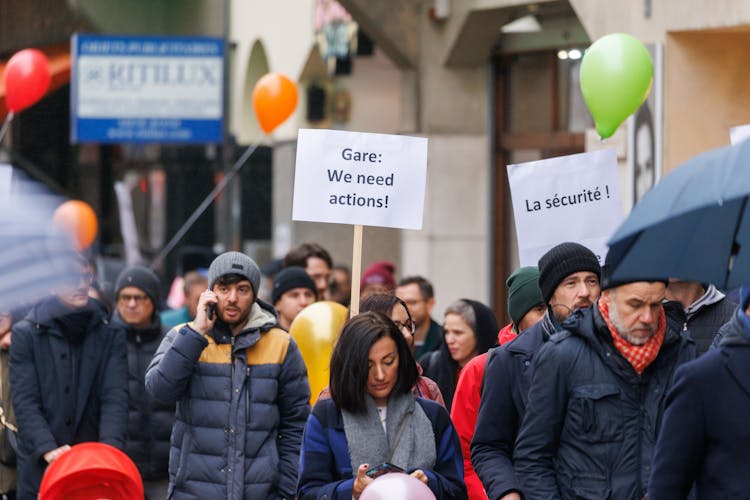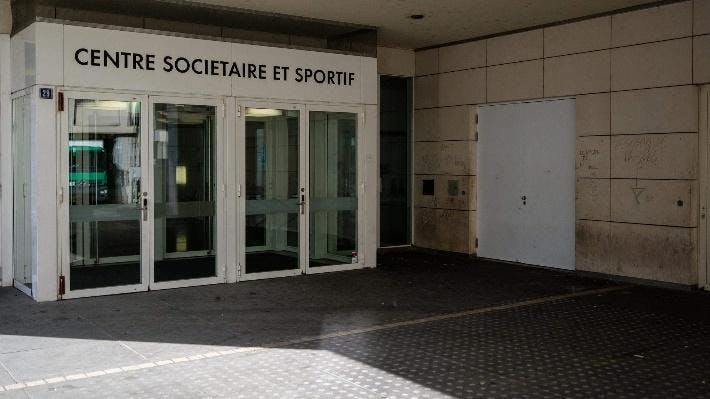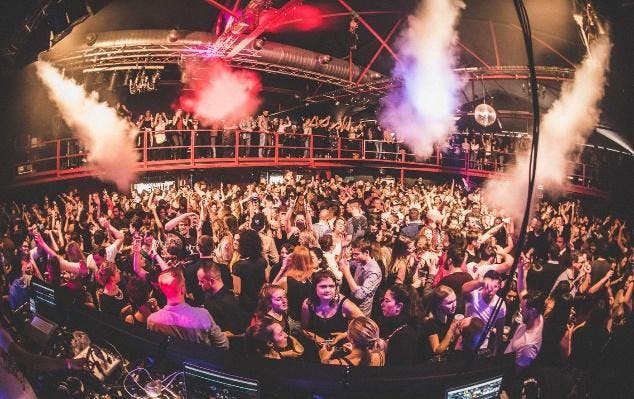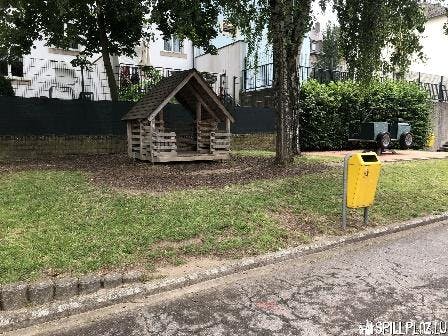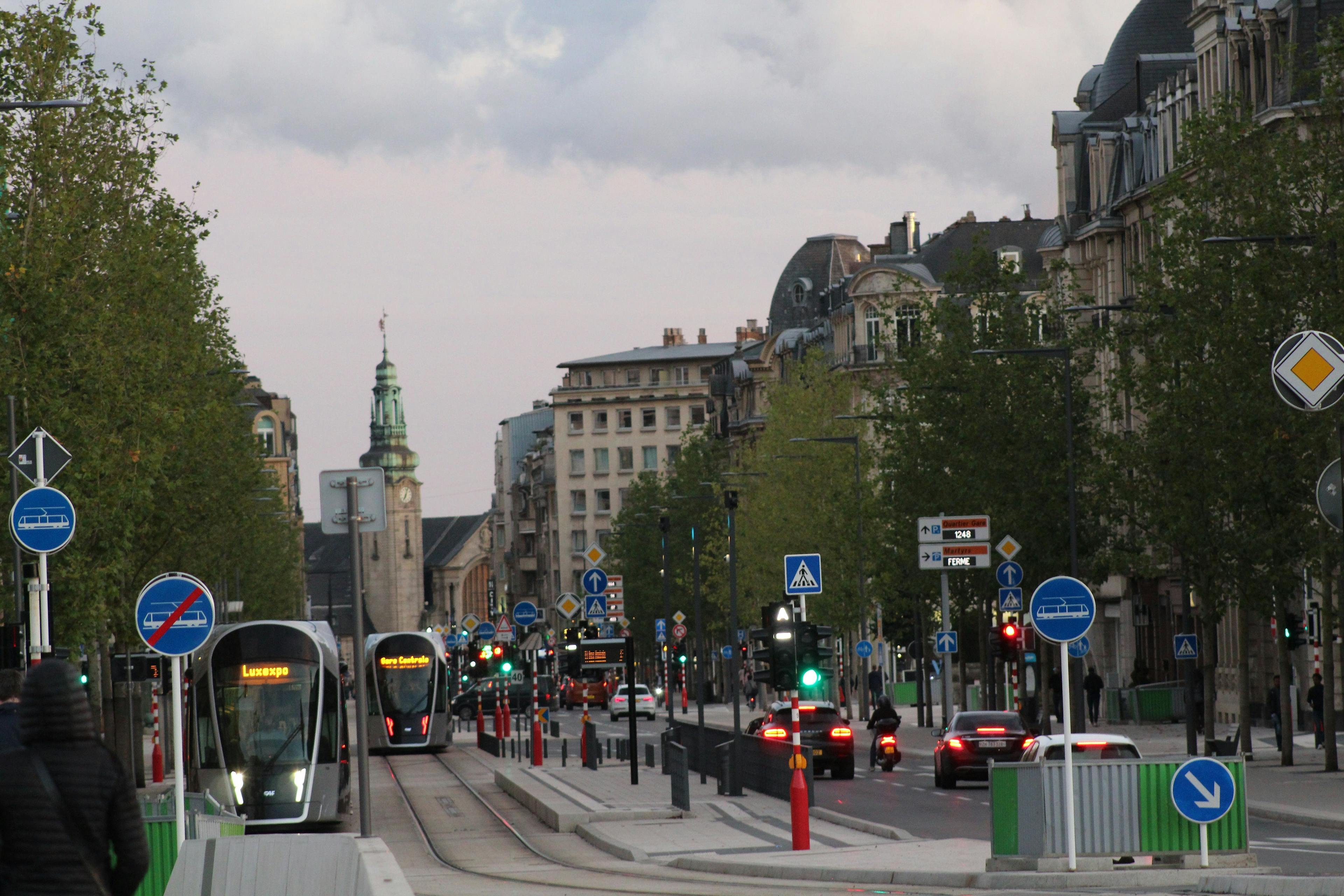
Gare: a transportation hub in the center of Luxembourg
In this article, we will navigate through the tapestry of Gare's past, explore its dynamic population, weigh the pros and cons of living within its boundaries, assess transport accessibility, and its infrastructure.
The Gare neighborhood, nestled in the heart of Luxembourg City, may be one of the smallest districts, yet boasts a vibrant and diverse community.
General characteristics of Gare
Bordered by the Ville Haute, Grund, Bonnevoie-Nord, Bonnevoie-Sud, Gasperich, and Hollerich, Gare is not only home to the central train station but also embraces a strategic location near the city center and its bustling commercial avenues. This prime positioning grants residents excellent mobility options.
Population of Gare
This neighborhood is a home to many people in Luxembourg, as it is a variable and multifaceted district in the heart of the City. It hosts
Notably, this district boasts the highest concentration of foreign residents among all city neighborhoods, accounting for an impressive 83.56% of its population. This demographic diversity adds a unique and cosmopolitan flavor to the Gare community, reflecting Luxembourg's status as a global hub.
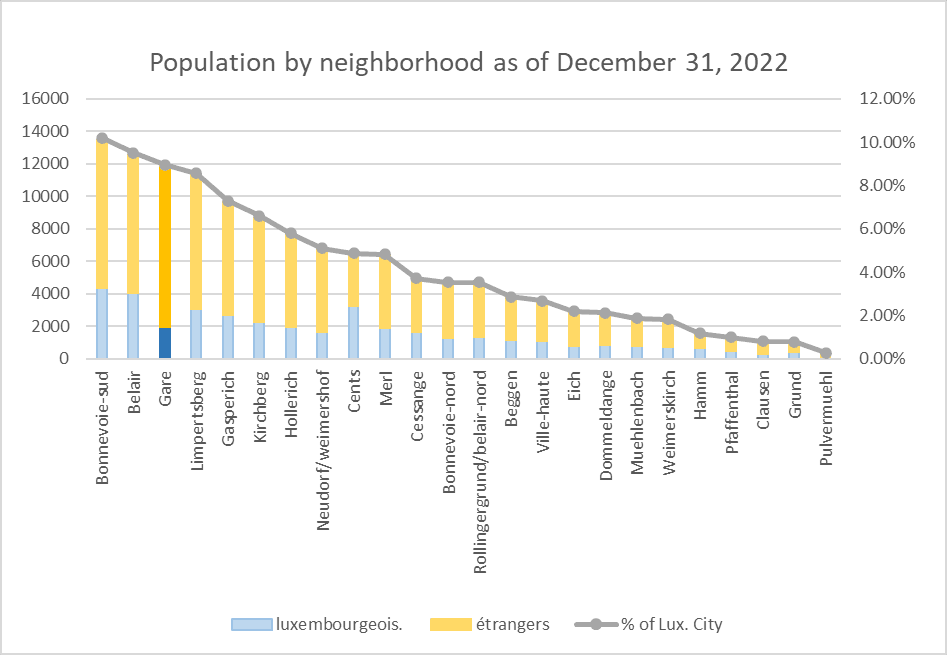
Being one of the top populated neighborhoods in the City, Gare presents a compelling mix of advantages and challenges for residents.
Transport accessibility
The Gare neighborhood boasts unparalleled transport accessibility, offering residents a variety of commuting options. Whether by car, tram, bus, bike, or on foot, navigating this vibrant district and reaching the city center is a seamless experience.
Here's a breakdown of the various transportation modes:





Renting and buying real estate
Real estate dynamics in the Gare neighborhood present a unique landscape, with purchase prices averaging at 10,390 euros/m2, notably lower than the capital's average of 12,243 euros/m2. This divergence is likely influenced by the neighborhood's challenging reputation, attributed to issues like prostitution, drugs, and minor delinquency.
For buying the average price is
For renting the average price is
On the leasing front, rental prices stand at 31.28 euros/m2, slightly exceeding the city's average of 30.53 euros/m2. This intriguing contrast between buying and renting reflects the nuanced real estate market in Gare, offering options that cater to different preferences and financial considerations.
Applications, search, and profound advice in our guide to renting
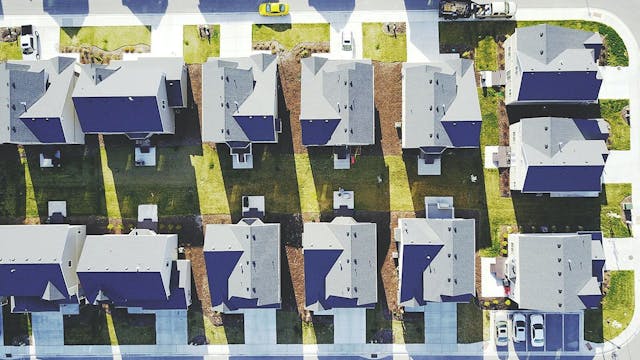
Infrastructure of the neighborhood
Discover the heartbeat of Gare through its robust infrastructure, seamlessly blending education, culture, health, recreation, and commerce. From the École de la Gare and the Clinique Zitha to the Centre Sociétaire et Sportif Gare, this neighborhood offers a rich tapestry of facilities.
If you're considering settling down in Luxembourg and have a preference for places on the city's periphery, you'll find our article on Bridel and Kopstal particularly insightful. Additionally, we invite you to peruse our collection of articles covering various communes and neighborhoods within the city.
Living in Gare: advantages and disadvantages
The Gare neighborhood presents a compelling mix of advantages and challenges for residents.
On the positive side, its stellar location and excellent mobility options, including proximity to the train station and a tram line running through the area, make it a highly accessible hub. Extensive bus routes further enhance connectivity, providing convenient travel to almost any destination.
However, a notable drawback persists despite the municipality's concerted efforts to improve safety. The streets surrounding the train station bear a notorious reputation, marked by issues like prostitution, drug-related activities, and minor criminal incidents, particularly during the nighttime.
While the local government is actively addressing these concerns, it remains an ongoing challenge, prompting residents to weigh the convenience of location against these security considerations.
In the winter of 2024, a demonstration was held in the capital where residents of the Gare spoke out to demand that the city authorities do the necessary efforts to make the neighborhood safer and change its reputation for the better.
What is there in this quartier of Luxembourg City?
There are many places to uncover in the Gare neighborhood: families with kids and working people will find it a great fit to suffice the need for quick and easy accsess not only to transportation, but also all commodities one might need living in the capital of the country. There are also parks like Place de Strasbourg and sports hubs like Jims Gym underline its commitment to holistic well-being. The diverse shopping scene completes the picture, making the Gare neighborhood a dynamic and vibrant place to live.
The Gare neighborhood fosters a nurturing environment for education with two childcare centers, an elementary school known as École de la Gare spanning three buildings, and a private high school, Lycée Fieldgen.
While the neighborhood doesn't host universities, its exceptional connectivity ensures easy access. For instance, reaching the Limpertsberg or Kirchberg campuses of the University of Luxembourg takes a mere 20 to 25 minutes by public transportation, offering residents convenient pathways to higher education.
Nurseries and day centers
Schools in Gare
Fieldgen High School
The Gare neighborhood boasts the Centre Sociétaire et Sportif Gare, a cultural hub hosting diverse events. However, the most prominent cultural center is the renowned concert venue, Den Atelier. This exceptional space hosts concerts, performances, and nightclub events, adding a vibrant touch to Gare's cultural scene.
While Gare itself offers cultural experiences, for a more extensive cultural palette, residents can easily explore neighboring areas. The central location and excellent connectivity make it quick and straightforward to discover additional cultural centers and events beyond the neighborhood.
Learn more about Luxembourg's culture and traditions in our special guide.
The Gare neighborhood is fortunate to host one of the four facilities comprising Hôpitaux Robert Schuman, the Clinique Zitha. This clinic is a crucial healthcare hub, housing significant departments such as neurosurgery and rheumatology.
If specific medical services are not available at Clinique Zitha, residents have quick and convenient access to other major healthcare centers. The Kirchberg Hospital and the Luxembourg Hospital Center, both reachable within approximately 25 minutes by public transportation, provide a broader range of medical departments and services.
- Address: 20-30 rue d'Anvers, Luxembourg
- Phone: (+352) 2 88 81
- Website: hopitauxschuman.lu
The Gare neighborhood offers delightful recreational spaces, including a public playground in Place de Strasbourg and two play areas adjacent to École de la Gare on Fischer Street and Commerce Street. These spaces are accessible to the public outside school hours.
Furthermore, the western and northern borders of the neighborhood are embraced by a green expanse along the Pétrusse River, providing a scenic pathway for leisurely strolls. Gare residents enjoy both well-maintained playgrounds and a serene natural retreat within their vibrant urban surroundings.
If you're an avid walker or hiker, there are many scenic routes to explore in the country, allowing you to immerse yourself further in the natural beauty and history of this charming Luxembourg neighborhood. Into hiking? Take a look at our dedicated article.
- Playground Fischer street: 92A rue Adolphe Fischer, Luxembourg
- Playground Commerce Street: 20 rue du Commerce, Luxembourg
- Playground place de Strasbourg: 1631 Gare, Luxembourg
The Gare neighborhood boasts a robust sports infrastructure, featuring the previously mentioned Centre Sociétaire et Sportif Gare, which caters to both cultural and sports events. Additionally, residents have access to two well-equipped gyms: one affiliated with the Jims fitness chain and the other being the Athletic Center gym. Both facilities offer fitness classes, dance sessions, martial arts, and more. Completing the array of options is La Salle, a dedicated sports venue.
The Gare neighborhood stands out as a vibrant shopping district, particularly along Rue de la Gare and the side of Place de Paris. This area offers an array of stores ranging from clothing, home decor, and cosmetics to bakeries, supermarkets, cafes, and restaurants.
Familiar chains enhance the shopping experience, with Monoprix, Delhaize, Carrefour Market, Cactus Market, H&M, and Sephora among the diverse options. The commercial diversity makes Gare a one-stop destination for all needs.
- Notably, Place de Paris hosts the Garer Maart every Thursday, adding a lively market atmosphere to the neighborhood. If this extensive shopping scene isn't enough, the city center is just a stone's throw away, and the neighborhood's excellent transportation links make reaching various shopping centers a breeze.
Historical overview
In the early 19th century, the Gare neighborhood was a modest enclave, its significance transforming dramatically with the integration into the Grand Duchy's railway network. The inauguration of the first train station in 1859 marked a pivotal moment, catalyzing the neighborhood's expansion.
Cigarettes and champagne
Independant district
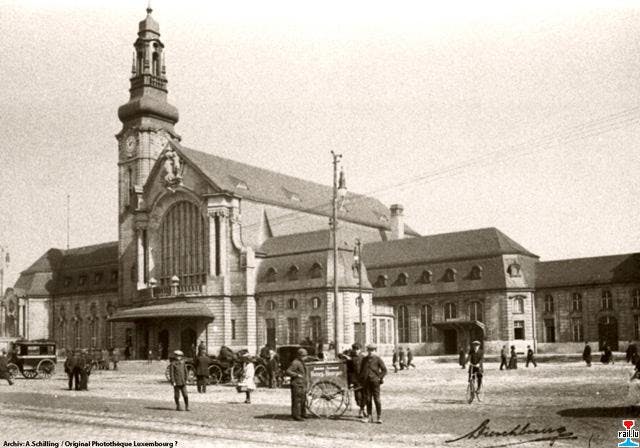
Frequently Asked Questions (FAQ)
What are the main challenges or concerns in the Gare neighborhood?
The Gare neighborhood faces challenges related to safety, with concerns about issues like prostitution, drugs, and minor delinquency in certain areas. Despite ongoing efforts, these aspects can impact the neighborhood's reputation.
How is the transportation infrastructure in Gare?
The Gare neighborhood boasts excellent transportation connectivity, featuring car-friendly routes, a comprehensive bus network, a traversing tram line, and proximity to the central train station. This infrastructure ensures residents have diverse and efficient options for commuting within and beyond the neighborhood.
What healthcare options are available in the Gare neighborhood?
Clinique Zitha, part of Hôpitaux Robert Schuman, is a key healthcare facility in Gare, offering services in departments like neurosurgery and rheumatology. Additionally, residents have quick access to Kirchberg Hospital and Centre Hospitalier de Luxembourg for comprehensive medical care.
Source: www.vdl.lu, www.justarrived.lu, fr.wikipedia.org, www.atelier.lu, www.hopitauxschuman.lu, www.jims.lu, www.athletic-center.lu, www.immotop.lu
We took photos from these sources: Alexandr Nagornyi, Felicia Varzari on Unsplash, Contacto.lu, Spillplaz.lu, editus.lu, Den Atelier, Ville de Luxembourg


